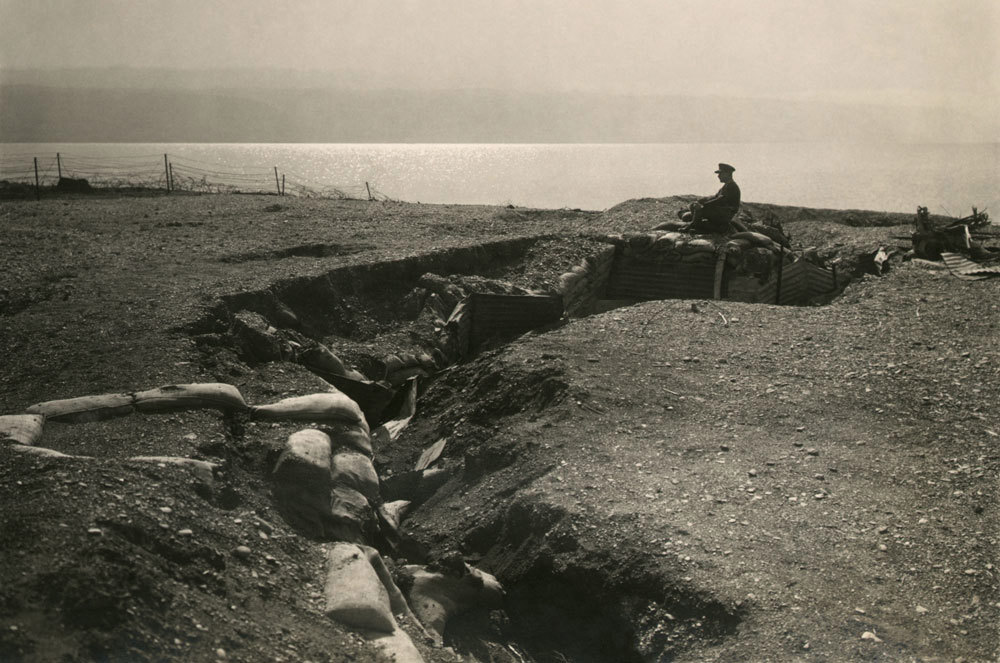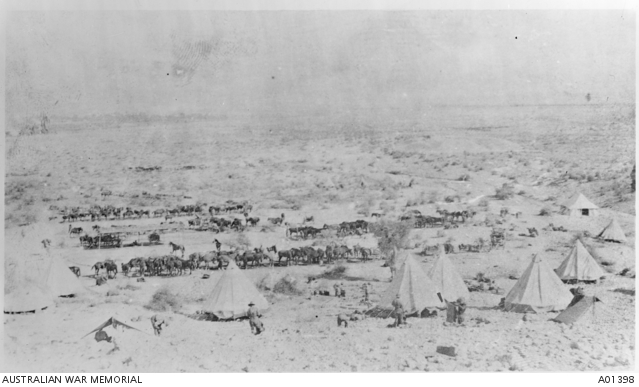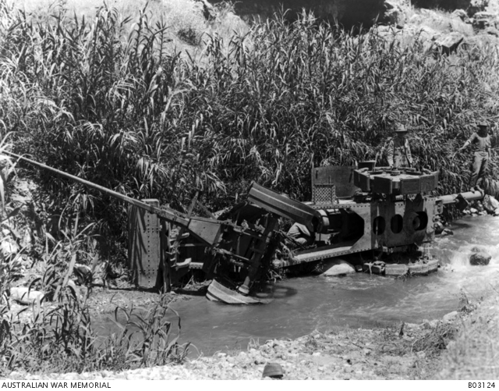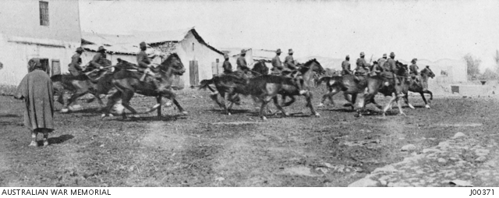21 February 2023
A push through the desert: How The Allies Captured Jericho in 1918
February 22nd, 1918. The Allies stand triumphant at Jericho. But how did they defeat their Ottoman opponents? Find out as well tell the story of the Capture of Jericho.
The Capture of Jericho
Prelude to Jericho: The War in the Middle East

Turkish trenches near the Dead Sea. The British and Ottoman Empires would clash in World War One's Middle East theatre (Wikimedia Commons)
Britain and Commonwealth troops had been officially at war in the Middle East since October 1914 – the date when the Ottoman Empire declared war on the Entente Powers.
The Ottoman Empire had controlled the region for centuries, but its time as a great power was ending. World War One offered the waning empire the chance to tighten its grip on its Middle East possessions.
The British Empires Middle Eastern war aims included:
- Protecting the Suez Canal
- Maintaining naval superiority in the Mediterranean
- Protecting its possessions in Egypt, the wider Middle East, India, and the Persian Gulf
- Maintaining the European balance of power
The first fighting took place in 1915 with an Ottoman attack on the Suez Canal. British, Indian, Australian, and New Zealand forces held a presence in the Middle East since that time.
Many campaigns were fought in wars of manoeuvre throughout the region. The most infamous is the Gallipoli Landings: a disastrous series of attempts to capture the Dardanelles between April 1915-January 1916.
However, since the setback at Gallipoli, the Allies and British had begun to win important victories against the Ottomans.
One of the most significant of these was the Battle of Beersheba in October 1917, featuring a mass ANZAC cavalry attack.
Jerusalem was captured by British and Commonwealth troops in December 1917.
Why did the Allies target Jericho in World War One?
 Image: General Edmund Allenby, commander of the EEF (Wikimedia Commons)
Image: General Edmund Allenby, commander of the EEF (Wikimedia Commons)
The British formation fighting in the Middle East at this time was known as the Egyptian Expeditionary Force (EEF). It was commanded by General Edmund Allenby.
Allenby had previously fought on the Western Front but had met limited success. Several costly failures were ascribed to his leadership, so he was reassigned to Middle East Command. However, since arriving in the region, Allenby had proved a re-energised effective battlefield commander.
General Allenby had masterminded the triumphs at Beersheba and Jerusalem. Unfortunately, Allenby and the EEF’s advance had ground to a halt. Rainy season put paid to any significant advances and the end of 1917 was a period of consolidation for the region’s British and Commonwealth forces.
Logistical issues plagued the Egypt Expeditionary Force. The winter 1917 advances had stretched its supply lines. Men and their mounts, horses, and camels alike, were running low on food. Advancing would be risky.
It was planning time for the EEF.
Allenby’s right flank was still wide open, leaving him exposed should he decide to attack Ottoman positions with a large display of force. The warm waters of the Mediterranean had protected his left, but Allenby still felt vulnerable.
By capturing Jericho, the EEF’s fright flank would be safe.
The basic idea was that an advance would push Allenby’s Ottoman opponents back over the Jordan River, secure some all-important river crossings, and pave the way for further operations against the Hedjaz Railway.
In the desert, railways were as important as food and water. They were a vital transport node, perfect for moving men and materiel across the shifting sands of the Middle East. Anything to put pressure on the Ottoman-controlled rail network would be a plus.
Who fought at the Capture of Jericho

View of the 3rd Australian Light Horse Brigade camp and horse lines at Jericho (Australian War Memorial)
Around 6,800 men formed the attacking force at the Capture of Jericho.
The men of the Egyptian Expeditionary Force assembled under General Allenby included men from the UK, Egypt, Australia, and New Zealand.
Men from XX Corps were represented by the 60th (London Division) and 53rd (Welsh) Division. Their commander was Lieutenant-General Phillip Chetwode.
Cavalry would play an important part in the battle, with the men of the Australian 1st Light Horse Brigade and New Zealand Mounted Rifles Brigade present in force as part of the Desert Mounted Corps.
The infantry and cavalry were supported from the skies by the aircraft of No.1 Squadron, Royal Flying Corps. Two aircraft from the Royal Australian Flying Corps had been harassing supply Turkish supply columns prior to the main march through to Jericho too.
In fact, several small villages around the town, as well as Hadjaz Railway station, had been the target of aerial bombers in the build-up.
Opposing Allenby’s EEF were 3,000 soldiers and officers of the Ottoman Yildirim Army Group. The defending Turkish troops had positioned themselves on several rocky outcrops and hilltops along the route to Jericho. They would provide staunch opposition to Allenby’s multinational force.
The Battle for Jericho begins
Infantry attack
 Image: Soldiers inspect a knocked-out Turkish artillery gun (Australian War Memorial)
Image: Soldiers inspect a knocked-out Turkish artillery gun (Australian War Memorial)
19th February 1918 saw the infantry of XX Corps being their advance towards their target: Jericho.
The terrain of the Judean Hills was rocky, rugged, and difficult to traverse. Machine-gun nests and Ottoman positions lay in the advancing EEF’s path too.
Contact was made between the 181st Brigade, London Regiment, and an Ottoman outpost of 300 men at Ras et Tawil. Despite suffering 50 casualties, the 181st Brigade was able to sweep aside armed resistance, capturing 25 prisoners and two machine guns.
To their north, at a location called El Muntar Iraq Ibrahim, high ground was captured by the 2/20th Battalion, London Regiment, at a cost of around 60 casualties. The remaining men of XX corps continued to push through the Judean Hills’ twisting, plunging network of valleys and wadis.
Mounted troops join the fray
XX Corps’ three infantry columns continued their advance towards Jericho on February 20th.
The village of Talat ed Dumm was captured on this day, following a harrowing bombardment from the big guns of the 10th Heavy Battery of the 383rd Siege Battery.
On the infantry’s right flank, the 179th Brigade moved up towards Jebel Ekteif, just south of Talat ed Dumm.
A sheer drop blocked the path of the brigade’s 2/13th Battalion, London Regiment, showing these men not only had Ottoman troops to contend with. Geography was as much an enemy as opposing soldiers. Having to traverse tight winding wadis, the battalion’s advance slowed.
The rest of the 179th soon engaged Ottoman opposition arrayed in trenches around Jebel Ekteif. By 08.15 on the morning of the 20th, the attack, spearheaded by the 2/15th Battalion, London Regiment, had captured the advance trenches and with them three companies of Ottoman soldiers.
The 179th Brigade soon captured a dominating position atop a hill overlooking the Jerusalem-Jericho Road, supported by heavy artillery. So far, so good for the attacking infantry.

Map showing the advance of the Anzac Mounted Division with Ottoman positions indicated in green (Wikimedia Commons)
Meanwhile, the New Zealand Mounted Rifles Brigade formed the vanguard for the 1st Light Horse Brigade as it winded its way through the barren valleys and hillsides ahead of them.
The thin valleys and wadis hemmed in the mounted cavalrymen, squeezing them into single-file formation. At one point, the New Zealanders were strung out up to five to eight miles. It would take hours before they were ready to assume attack formation.
By 06.00, the advance elements of the Mounted Brigade had reached their forward positions at and began an assault on a rocky outcrop called Hill 306. At 12.00, the men of the Auckland Mounted Rifles Regiment and their mounts began an attack on the nearby Hill 288. Both were captured soon after.
Further mounted assaults were launched on positions along the Ottoman line from Tibq el Quentira to Jebel al Kahmum across the rest of the day. Two positions were taken by 14.00 but the assault stalled once the Ottomans retreated to a heavily defended area called Nebi Musa.
Australian War Photographer Frank Hurley was with the 1st Light Horse Brigade during their time campaigning towards Jericho. He described the conditions the cavalrymen faced during their march through the Judean Hills:
“Even in daylight I should not have dreamt of riding this track [down the Wadi Qumran to the valley of the Jordan], and yet the whole brigade passed along it without mishap. At 11.00pm we were at the arranged position, and after tethering out the horses rolled ourselves up in our blankets. The night was bitterly cold, and we missed our "bivvies", orders having been given to travel light, so that every man rode with an absolute minimum weight. We are to leave here at 3.30 am to attack NebI Musa.”
February 21st: Jericho is captured

Allied Commanders celebrate the capture of Jericho with a spot of tea. Their position was shelled shortly after (Wikimedia Commons)
Under cover of darkness, the New Zealand Mounted Rifles began to advance across rough track towards Nebi Musa. Dismounting, they launched a frontal assault while the British Infantry attacked from the rear, catching the Ottomans in a pincer movement.
Nebi Musa was captured as the sun rose, forcing the Ottoman garrison to withdraw along with their guns.
The Ottoman troops arrayed in the valleys and hills around Jericho had been hit so hard by Allenby’s EEF they had no choice but to fall back completely.
 Image: Men of the 1st Light Horse Brigade thunder into Jericho (Australian War Memorial)
Image: Men of the 1st Light Horse Brigade thunder into Jericho (Australian War Memorial)
When the 1st Light Horse Brigade reached Jericho at 08.00 on the morning of February 21st, they found no trace of the Turkish garrison. The city was in British hands.
In a piece of typical Britishness, Divisional HQ stopped for a tea break around one mile behind the captured city.
New Zealand General Edward Cheytor, who had commanded the mounted elements of the EEF’s attack on Jericho, sat down on the footstep of his staff car to take the weight off his feet and contemplate a well-fought victory.
Suddenly, the world around him exploded. Chaytor, as well as General Chetwode and other senior commanders, were targeted by big guns from across the Jordan river. Shellfire screamed out of the sky in a deadly metallic rain, pummelling their position, killing and wounding many men.
Following the bombardment, the EEF had taken over 500 casualties; a sad denouement on an otherwise relatively bloodless campaign.
Aftermath
On February 22nd, the British Army and its ANZAC elements, plus Egyptian troops, were in control of Jericho.
They had advanced an impressive 20 miles through harsh terrain in the face of strong opposition. Compared with the minimal gains made on the Western Front, this was a huge advance.
The war in the Middle East was a much quicker affair than the static trench warfare with cavalry still playing an important role in battlefield manoeuvres and fighting.
Strategically, this put the British in a strong position to continue to press the Ottomans in Palestine and beyond. Jericho was the culmination point for some of the region’s most important roads, including the main highway to Jerusalem and the links to the coast.
Casualties of the capture of Jericho
As ever, the victory at Jericho had come at a cost. Around 600 casualties had been taken. Ottoman losses are unknown but at least 140 men were taken prisoner along with 8 machine guns.
Casualties from the capture of Jericho are commemorated at numerous Commonwealth War Graves sites in Israel and Palestine including:
Uncover more stories of the Fallen with Commonwealth War Graves
Our search tools can help you uncover more stories of those commemorated by the Commonwealth War Graves Commission.
Use our Find War Dead tool to search for specific casualties by name, where they served, which branch of the military they served in, and more parameters.
Looking for a specific location? Use our Find Cemeteries & Memorial search tool to find all our sites. You can search by country, locality, and conflict.

